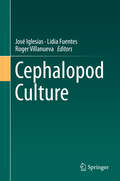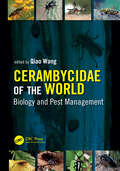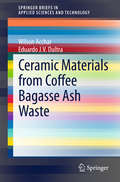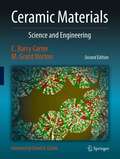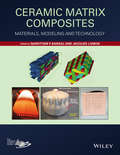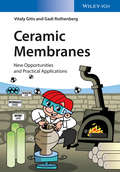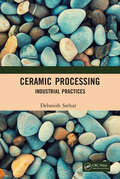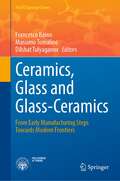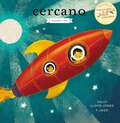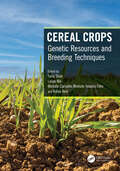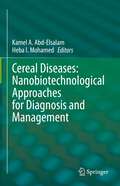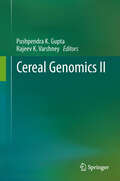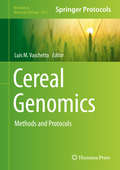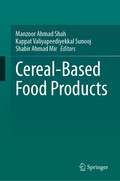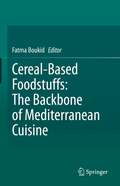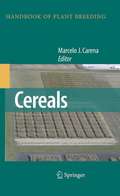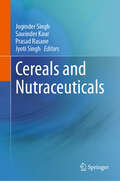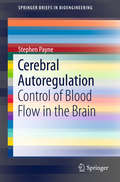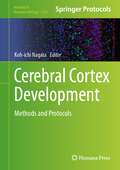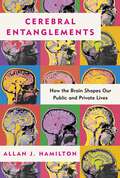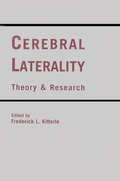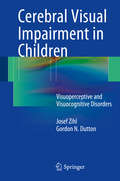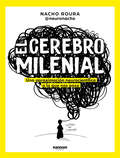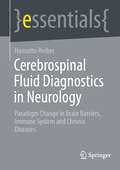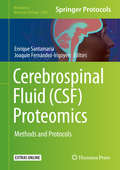- Table View
- List View
Cephalopod Culture
by José Iglesias Lidia Fuentes Roger VillanuevaCephalopod Culture is the first compilation of research on the culture of cephalopods. It describes experiences of culturing different groups of cephalopods: nautiluses, sepioids (Sepia officinalis, Sepia pharaonis, Sepiella inermis, Sepiella japonica Euprymna hyllebergi, Euprymna tasmanica), squids (Loligo vulgaris, Doryteuthis opalescens, Sepioteuthis lessoniana) and octopods (Amphioctopus aegina, Enteroctopus megalocyathus, Octopus maya, Octopus mimus, Octopus minor, Octopus vulgaris, Robsonella fontaniana). It also includes the main conclusions which have been drawn from the research and the future challenges in this field. This makes this book not only an ideal introduction to cephalopod culture, but also a valuable resource for those already involved in this topic.
Cerambycidae of the World: Biology and Pest Management (Contemporary Topics in Entomology)
by Qiao WangWang has gathered contributions from an impressive cohort of the world’s most respected experts on longhorned beetles. Chapters review both basics of cerambycid taxonomy, mor- phology, and behavior (feeding, reproduction, and chemical ecology), as well as more applied concerns, such as laboratory rearing, pest control, and bio- security. Overall, this volume is a valuable contribution to the literature as a "one-stop shop" for readers seeking a comprehensive overview of longhorned beetles... It represents a tremendous effort on the part of Wang and the authors, and has resulted in a much-needed update to the literature. This volume is the only work of its kind available at this time, and is a valuable addition to the library of any scientist studying wood-boring beetles. - Ann M. Ray, Biology, Xavier University, Cincinnati, Ohio in The Quarterly Review of Biology, Volume 94, 2019 There are more than 36,000 described species in the family Cerambycidae in the world. With the significant increase of international trade in the recent decades, many cerambycid species have become major plant pests outside their natural distribution range, causing serious environmental problems at great cost. Cerambycid pests of field, vine, and tree crops and of forest and urban trees cost billions of dollars in production losses, damage to landscapes, and management expenditures worldwide. Cerambycidae of the World: Biology and Pest Management is the first comprehensive text dealing with all aspects of cerambycid beetles in a global context. It presents our current knowledge on the biology, classification, ecology, plant disease transmission, and biological, cultural, and chemical control tactics including biosecurity measures from across the world. Written by a team of global experts, this book provides an entrance to the scientific literature on Cerambycidae for scientists in research institutions, primary industries, and universities, and will serve as an essential reference for agricultural and quarantine professionals in governmental departments throughout the world.
Ceramic Materials from Coffee Bagasse Ash Waste (SpringerBriefs in Applied Sciences and Technology)
by Wilson Acchar Eduardo J. V. DultraThis book proposes the use of coffee bagasse ash (CBA) waste as raw material to be used in ceramic formulations. The approach presented here is a solution to a current ambiental problem as CBA waste is discharged in high amounts in agriculture. The authors analyze the potencial of CBA as a material to substitute feldspar in tile production.
Ceramic Materials: Science and Engineering
by C. Barry Carter M. Grant NortonCeramic Materials: Science and Engineering is an up-to-date treatment of ceramic science, engineering, and applications in a single, comprehensive text. Building on a foundation of crystal structures, phase equilibria, defects, and the mechanical properties of ceramic materials, students are shown how these materials are processed for a wide diversity of applications in today's society. Concepts such as how and why ions move, how ceramics interact with light and magnetic fields, and how they respond to temperature changes are discussed in the context of their applications. References to the art and history of ceramics are included throughout the text, and a chapter is devoted to ceramics as gemstones. This course-tested text now includes expanded chapters on the role of ceramics in industry and their impact on the environment as well as a chapter devoted to applications of ceramic materials in clean energy technologies. Also new are expanded sets of text-specific homework problems and other resources for instructors. The revised and updated Second Edition is further enhanced with color illustrations throughout the text.
Ceramic Matrix Composites
by Narottam P. Bansal Jacques LamonThis book is a comprehensive source of information on various aspects of ceramic matrix composites (CMC). It covers ceramic and carbon fibers; the fiber-matrix interface; processing, properties and industrial applications of various CMC systems; architecture, mechanical behavior at room and elevated temperatures, environmental effects and protective coatings, foreign object damage, modeling, life prediction, integration and joining. Each chapter in the book is written by specialists and internationally renowned researchers in the field. This book will provide state-of-the-art information on different aspects of CMCs. The book will be directed to researchers working in industry, academia, and national laboratories with interest and professional competence on CMCs. The book will also be useful to senior year and graduate students pursuing degrees in ceramic science and engineering, materials science and engineering, aeronautical, mechanical, and civil or aerospace engineering.Presents recent advances, new approaches and discusses new issues in the field, such as foreign object damage, life predictions, multiscale modeling based on probabilistic approaches, etc.Caters to the increasing interest in the application of ceramic matrix composites (CMC) materials in areas as diverse as aerospace, transport, energy, nuclear, and environment. CMCs are considered ans enabling technology for advanced aeropropulsion, space propulsion, space power, aerospace vehicles, space structures, as well as nuclear and chemical industries.Offers detailed descriptions of ceramic and carbon fibers; fiber-matrix interface; processing, properties and industrial applications of various CMC systems; architecture, mechanical behavior at room and elevated temperatures, environmental effects and protective coatings, foreign object damage, modeling, life prediction, integration/joining.
Ceramic Membranes: New Opportunities and Practical Applications
by Gadi Rothenberg Vitaly GitisWritten by two internationally renowned authors in the sciences and engineering to ensure a multidisciplinary approach, this is the essential textbook on a growing field that is increasingly finding industrial applications. Following an introduction to ceramic membranes, the text goes on to treat the fundamentals of membrane separation, followed by an overview of characterization techniques, applications, and the economics. Each chapter ends with qualitative and quantitative exercises, as well as around 150 literature references. An accompanying website features solutions to selected exercises, as well as PowerPoint slides of all of the figures in the book, and a full list of all references complete with their DOIs. Since membrane processes are usually taught either at the end of the undergraduate degree or during graduate studies, this textbook is aimed at both senior undergraduates and graduate researchers.
Ceramic Processing: Industrial Practices
by Debasish SarkarThis book gives a comprehensive account on the manufacturing techniques to synchronize the desired properties of both traditional and advanced ceramics. Offers exclusive and up to date information on industrial ceramic processing equipment and approaches and discusses actual industrial practices taking a product-oriented approach It should serve as a text to answer the processing of ceramics and achieve targeted product in industrial environment.
Ceramics, Glass and Glass-Ceramics: From Early Manufacturing Steps Towards Modern Frontiers (PoliTO Springer Series)
by Francesco Baino Massimo Tomalino Dilshat TulyaganovThis book presents a state-of-the-art overview of the major aspects involved in the science, technology and applications of ceramics, glasses and glass-ceramics. After providing an historical perspective of the development and use of ceramics and glasses along the Silk Road, the theoretical background and fabrication techniques of such materials are described and discussed. A special focus is dedicated to emerging high-tech applications in various fields, including medicine, energy, optics and photonics, sensors, sustainability and circular economy. The chapters are written by leading experts in their respective fields and highlight the contemporary challenges associated to each topic. This book will serve as a valuable reference for both early-stage and skilled researchers as well as industry professionals interested in the broad field of glasses and ceramics.
Cercano: Salmo 139
by Sally Lloyd-JonesDe Sally Lloyd-Jones, autora del best seller Historias Bíblicas de Jesús, viene un nuevo libro edificante en un formato acolchado suave que es perfecto para pequeñas manos. Inspirado por el salmo 139 que comienza: «Oh Señor, me has buscado y me conoces». El texto lírico de Cercano les recuerda a los pequeños que Dios está con ellos donde quiera que vayan en el amplio mundo de Dios.Dios es mi Padre que hizo todo.Y yo soy un pequeño explorador del mundo entero.Él está cerca de míY él me protege.Él me veY él me conoce.Él es fuerteY Él me cuida.Él está conmigo, ¡siempre!NearFrom Sally Lloyd-Jones, the author of the bestselling The Jesus Storybook Bible, comes an uplifting new board book in a soft padded format that is a perfect fit for little hands. Inspired by Psalm 139-which begins, "O Lord, you have searched me and you know me" Near's lyrical text reminds little ones that God is with them anywhere they go in God's wide world.God is my Father who made everything.And I am a little explorer of the wide world.He is near meAnd he protects me.He sees meAnd he knows me.He is strongAnd he looks after me.He is with me-always!
Cereal Crops: Genetic Resources and Breeding Techniques
by Tariq Shah, Lixiao Nie, Marcelo Carvalho Minhoto Texeira Filho, and Rabia AmirCereal Crops: Genetic Resources and Breeding Techniques provides the reader practical tools for understanding relationships and challenges of successful farming; improvements to genetic modifications; and environmentally sound methods of production of bulk and quality cereals including wheat, maize, rice, barley, and millets. It explores the trait mapping, cropping systems, genome engineering, and identification of specific germplasms needed for the more effective development of biotic and abiotic stress resistant cereals within the framework of ensuring future food supplies around the world. Features:Focuses on cropping systems, genetics and genome engineering for higher crop production at a global level.Features information on specific prebiotic formulas to ward off adverse effects of antibiotics.Covers mechanistic as well as practical approaches for enhancing crop production in a sustainable way.Includes further in-depth analysis of various topics following each chapter.This is a vital resource for researchers, crop biologists, and students working with crop production and climate changes that have a significant impact on crop production, spanning basic to advanced level discussions of plant breeding, molecular genetics, and agronomy. Covering mechanistic and practical approaches for enhancing crop production in a sustainable way, this text is beneficial to intensive farmers and stakeholders in the field of crop production.
Cereal Diseases: Nanobiotechnological Approaches for Diagnosis and Management
by Kamel A. Abd-Elsalam Heba I. MohamedNew ways to improve cereal crops against fungal, bacterial, and viral diseases are covered in this book that was put together by a group of experts. These include genetics, genome editing systems, and nano-biotechnological tools. Cereal crops are mainly the world's leading food crops and feed a large share of the world population. However, external factors, such as pathogens, have often threatened their productivity. Like wheat, rice, maize, oats, barley, millet and storage, etiology, epidemiology, and diseases in cereal crop management. In addition, the importance of crop genetics and genomics in combating pathogens has been discussed. This book offers up-to-date information on new methods, such as the potential of the genome editing system for crop improvement, in particular the CRISPR-Cas system. The current volume also talks about identification, plant breeding, genome editing, and nanotechnology tools that can be used to fight disease in cereal crops. This book is good for students, teachers, and researchers who study biotic stress in cereals, as well as scientists who study nanotechnology, disease resistance, pathogen biology, genome editing, agriculture sciences, and future biotechnology.
Cereal Genomics II
by Rajeev Varshney Pushpendra K. Gupta"Cereal Genomics" published in 2004 served the purpose of collecting all information on cereal genomics at one place and was well received by the cereal workers through-out the world. The last eight years have witnessed significant advancement in the field of cereal genomics. For instance, high-density genetic maps, physical maps, QTL maps and even draft genome sequence have become available for several cereal species. Furthermore, the next generation sequencing (NGS) technologies have revolutionized genomics research, so that it is possible now to sequence genomes of hundreds or thousands of accessions of an individual cereal crop. Significant amounts of data generated using these NGS technologies created a demand for computational tools to analyse this massive data. In view of these developments, the Editors realised that there was a need to have an updated volume on the present status and future prospects of cereal genomics. These developments related to technology and the tools have been documented in this volume, thus supplementing our earlier edited volume "Cereal Genomics". "Cereal Genomics II" discusses advances in cereal genomics research made during the last eight years, and presents state-of-art cereal genomics and its utilization involving both basic research such as comparative genomics and functional genomics, and applied research like QTL mapping and molecular breeding.
Cereal Genomics: Methods and Protocols (Methods in Molecular Biology #2072)
by Luis M. VaschettoThe objective of this volume is to detail current technologies associated with cereal genomics, providing a valuable resource for researchers working in breeding and molecular crop improvement programs. Chapters guide readers through high-throughput DNA extraction protocols, crop genetic resources, meta-Quantitative Trait Loci (QTL) analysis, association mapping, next-sequencing generation, transposable element-associated variation, transcriptomics analysis, epigenetic variation, identification of imprinted genes, noncoding RNAs (circular RNAs), genome editing technologies, and post-translational protein phosphorylation.Written in the highly successful Methods in Molecular Biology series format, chapters include introductions to their respective topics, lists of the necessary materials and reagents, step-by-step, readily reproducible laboratory protocols, and tips on troubleshooting and avoiding known pitfalls. Authoritative and cutting-edge, Cereal Genomics: Methods and Protocols to ensure successful results in the further study of this vital field.
Cereal-Based Food Products
by Manzoor Ahmad Shah Shabir Ahmad Mir Kappat Valiyapeediyekkal SunoojCereal grains and their products are staples in the diet of almost every culture of the world and have made an important contribution to daily nutrient requirements. Cereal grains are high in carbohydrates, good sources of protein and provide varying amounts of fibre, vitamins and minerals. The nutritional composition of grains may vary depending on the variety and environmental growing conditions. A number of cereal products are prepared from all the regions of the world. Cereals are processed into many products such as bread, cookies, cakes and pasta and are consumed daily by the majority of the population and play an important place in human nutrition. Cereal Based Food Products is the first book of its kind, focusing on the preparation methodology of cereal products. The chapters focus on different types of cereal products, processing technology, quality aspects and packaging requirements. All of the important cereal-based foods are covered in full, including sections on bread, cookies, cakes and muffins, pasta and noodles and many more including their packaging, preparation methods and ingredients. With this text researchers will find a comprehensive single source for information on the processing of cereal-based food products.Covers different types of products prepared from cereal grains;Focuses on production technology for the development of cereal products;Presents information on packaging requirements of cereal products.
Cereal-Based Foodstuffs: The Backbone of Mediterranean Cuisine
by Fatma BoukidCereal-Based Foodstuffs: The Backbone of the Mediterranean provides an overview of cereal-based products in the Mediterranean region, illustrating the spectrum of products from past to present and their various processing methods. The text explores new and understudied market trends in cereal-based products, such as cereal-pulse blends, pulse pastas, and flat breads. Chapters cover products originating in North Africa, such as bulgur and couscous, which are consumed worldwide but underrepresented in the scientific literature. Contributing authors also offer a legislative perspective on issues of food safety, the European Food Safety Association’s definition of “novel foods,” and the position of traditional foods in the Mediterranean food industry. This wide-ranging text thus serves members of both the scientific and industrial community seeking better coverage of global cereal product trends.
Cereals (Handbook of Plant Breeding #3)
by Marcelo J. CarenaAgriculture depends on improved cultivars, and cultivars are developed through proper plant breeding. Unfortunately, applied plant breeding programs that are focused on cereal commodity crops are under serious erosion because of lack of funding. This loss of public support affects breeding continuity, objectivity, and, perhaps equally important, the training of future plant breeders and the utilization and improvement of plant genetic resources currently available. Breeding programs should focus not only on short-term research goals but also on long-term genetic improvement of germplasm. The research products of breeding programs are important not only for food security but also for commodity-oriented public and private programs, especially in the fringes of crop production. Breeding strategies used for long-term selection are often neglected but the reality is that long-term research is needed for the success of short-term products. An excellent example is that genetically broad-based public germplasm has significantly been utilized and recycled by industry, producing billions of dollars for industry and farmers before intellectual property rights were available. Successful examples of breeding continuity have served the sustainable cereal crop production that we currently have. The fact that farmers rely on public and private breeding institutions for solving long-term challenges should influence policy makers to reverse this trend of reduced funding. Joint cooperation between industry and public institutions would be a good example to follow. The objective of this volume is to increase the utilization of useful genetic resources and increase awareness of the relative value and impact of plant breeding and biotechnology. That should lead to a more sustainable crop production and ultimately food security. Applied plant breeding will continue to be the foundation to which molecular markers are applied. Focusing useful molecular techniques on the right traits will build a strong linkage between genomics and plant breeding and lead to new and better cultivars. Therefore, more than ever there is a need for better communication and cooperation among scientists in the plant breeding and biotechnology areas. We have an opportunity to greatly enhance agricultural production by applying the results of this research to meet the growing demands for food security and environmental conservation. Ensuring strong applied plant breeding programs with successful application of molecular markers will be essential in ensuring such sustainable use of plant genetic resources.
Cereals and Nutraceuticals
by Jyoti Singh Joginder Singh Sawinder Kaur Prasad RasaneThis book is focused on the production, cultivation, processing, composition, nutritional value, value addition, health implications, limitations and safety of nutricereals with an emphasis on their functional significance. With changing food habits and increasing health concerns, consumers around the world are opting for a more nutritious diet than that was consumed until recently. Nutricereals are now becoming a food of choice for many and newer products are being developed using them. Thus, a better understanding of these valuable crops is becoming essential. Researchers and scientists around the world have now turned their attention to nutricereals as a cheaper and most important solution to nutritional deficiencies. Processing of these cereals is matter of advanced research in recent times to make it suitable and palatable for human consumption and taste, and hence high emphasis is given on processing and value addition of these cereals. A comprehensive account of these important aspects is highly required. The book covers specific aspects of the nutricereals of consumption pattern and acceptance and the cultivation practices and health benefits associated with their consumption. Considerations on processing, value addition and safety associated with various nutricereals and current and future challenges and the opportunities for its utilization are highlighted in the book. This book forms an important resource on nutricereals for food technologists and food scientists.
Cerebral Autoregulation: Control of Blood Flow in the Brain (SpringerBriefs in Bioengineering)
by Stephen PayneThis Briefprovides a comprehensive introduction to the control of blood flow in thebrain. Beginning with the basic physiology of autoregulation, the author goeson to discuss measurement techniques, mathematical models, methods of analysis,and relevant clinical conditions, all within this single volume. The author drawstogether this disparate field, and lays the groundwork for future researchdirections. The textgives an up-to-date review of the state of the art in cerebral autoregulation,which is particularly relevant as cerebral autoregulation moves from thelaboratory to the bedside. CerebralAutoregulation will be useful to researchers in the physical sciences suchas mathematical biology, medical physics, and biomedical engineering whose workis concerned with the brain. Researchers in the medical sciences and cliniciansdealing with the brain and blood flow, as well as industry professionalsdeveloping techniques such as ultrasound, MRI, and CT will also find this Briefof interest.
Cerebral Cortex Development: Methods and Protocols (Methods in Molecular Biology #2794)
by Koh-Ichi NagataThis volume explores the latest developments in the study of the cerebral cortex. The chapters in this book cover a wide array or established methods such as in situ hybridization of brain slices; two-photon FRET/FLIM imaging of cerebral neurons; BioID analysis of actin-binding proteins; generation of iPS cells using Sendai Virus vectors; in vivo whole-cell recording from the mouse brain; and locomotor assays in Drosphila larvae and adult flies. Written in the highly successful Methods in Molecular Biology series format, chapters include introductions to their respective topics, lists of the necessary materials and reagents, step-by-step, readily reproducible laboratory protocols, and tips on troubleshooting and avoiding known pitfalls.Comprehensive and thorough, Cerebral Cortex Development: Methods and Protocols is a valuable resource that will help both expert and novice researchers further enhance their understanding of this important field.
Cerebral Entanglements: How the Brain Shapes Our Public and Private Lives
by Allan J. HamiltonA profound and profoundly important book that, using the most up-to-date revolutionary discoveries in neuroscience, shows us how to understand the brain; how it allows us to think, feel, experience and perceive, written by an acclaimed Harvard-trained neurosurgeon.It took a brain surgeon who&’s spent a lifetime in the operating room experiencing the brain's union of form and function to write this book. Cerebral Entanglements, unlike most books on the brain, looks at the intimate and vital emotions in our lives, and shows as well, how neuroimaging studies can transform our understanding of crucial emotional or mental health concerns. Why do we love? Why do we hate? Why do we kill? Why do we laugh? Why do we have faith? Why does time stand still or speed up? Focusing on the nature of consciousness, affection, trust, romance, empathy, kindness; prejudice, sadness, happiness, depression, grief, and the nature of laughter, the author shows us how neuroscience has changed our understanding of these emotions as he explores the extraordinary revelations that have emerged from brain imaging and functional studies. We see that we are the first generation to perceive the contours of a human thought, track the course of an emotion, even watch memory come together. Allan Hamilton writes clearly and accessibly, about the complex science driving our emotions and experiences, and shows how our newfound knowledge can impact our well-being, individually and as a society. As the book explores the nature of happiness, laughter, stress, PTSD. Hamilton writes about how the brain perceives and experiences music, memory, and time itself.
Cerebral Laterality: Theory and Research
by Frederick L. KitterleResearch on clinical populations and studies of normal individuals support the conclusion that there are functional differences between the cerebral hemispheres. This book captures some of the major developments in the field of cerebral laterality research of the last five years. These include lateralization in non-human primates, computational models of hemispheric processing, hemispheric transfer and interaction, perceptual asymmetries, techniques to measure dynamic changes in hemispheric processing of information, and new conceptualizations of the relation between handedness and cerebral laterality. The topics discussed exhibit an interconnectedness such that the approaches and techniques used in one area of cerebral laterality research have implications for research in other disciplines. They also reflect changes in the conceptualization of general theoretical issues regarding cerebral laterality research.
Cerebral Visual Impairment in Children: Visuoperceptive and Visuocognitive Disorders
by Gordon N. Dutton Josef ZihlCerebral visual disorders have far-reaching consequences for child development. These have profound adverse effects on children's education and success in school and also in later life, but, unfortunately, cerebral visual disorders often remain undiagnosed and untreated in the pediatric population. This book provides a state-of-the-art account of what is known about the development and disorders of visual perception in children. It covers the development and disorders of visual perception in children, their assessment, early intervention and management in an interdisciplinary context, both from a scientific as well as clinical perspective. Case studies illustrate the recommended assessment and rehabilitation procedures; synopses, boxes and check-lists complement the presentation of our recommendations for clinical practice.
Cerebro milenial: Ansiedad, tipos de orientaciones y de identidades sexuales, redes sociales, salud mental y todas las cuestiones existenciales del mundo
by Nacho Roura @NeuronachoUn libro para entender, de una vez por todas y con explicación científica incluida, por qué nos pasa lo que nos pasa a los milenials. «¿Qué es el cerebro milenial?», dices mientras clavas tu pupila en mi perfil de Instagram. Ansiedad, síndrome del impostor, nuevos tipos de amor e identidades, redes sociales... y un montón de cosas son los temas centrales de esta generación marcada por las crisis económicas, la precariedad laboral y los memes virales. Un retrato social actual para entender por qué somos como somos y qué define a la generación milenial desde el punto de vista neurológico y científico. Un libro de divulgación accesible y divertido para finalmente descodificar y entender cómo funciona el cerebro milenial.
Cerebrospinal Fluid Diagnostics in Neurology: Paradigm Change in Brain Barriers, Immune System and Chronic Diseases (essentials)
by Hansotto ReiberThis Springer essential explains the theoretical foundations for knowledge-based interpretation of medical laboratory data. Self-organization of biological structure, non-linear dynamics of complex systems and immunological network theories make it possible to describe pathomechanisms and diagnostics, especially of chronic diseases, as an expression of a phenotypic biology and to develop concepts for causal therapies.The book shows how CSF diagnostics with a diagnostic report integrating all laboratory data can identify disease-typical patterns for the differential diagnosis of bacterial, viral, parasitic, oncological, chronic inflammatory, autoimmunological and psychiatric diseases. A CSF app is provided as a tutorial program.The translation from German was done with the help of artificial intelligence. A subsequent human revision was done primarily in terms of content.
Cerebrospinal Fluid: Methods and Protocols (Methods in Molecular Biology #2044)
by Enrique Santamaría Joaquín Fernández-IrigoyenThis volume focuses on protein analysis, including a wide range of the use of mass spectrometry and other protein methods within neurobiological disciplines. Chapters cover topics such as cerebrospinal fluid (CSF) processing and biobanking; label-free quantitative proteomics; SWATH; top-down proteomics; and experimental strategies based on other –omics applied to CSF metabolome, lipidome, and microRNAome. Written in the highly successful Methods in Molecular Biology series format, chapters include introductions to their respective topics, lists of the necessary materials and reagents, step-by-step, readily reproducible laboratory protocols, and tips on troubleshooting and avoiding known pitfalls.Cutting-edge and thorough, Cerebrospinal Fluid (CSF) Proteomics: Methods and Protocols is a valuable resource for graduate students and post-doctoral fellows interested in learning more about CSF proteotyping. It is also useful to established researchers seeking further insight into this growing field.
